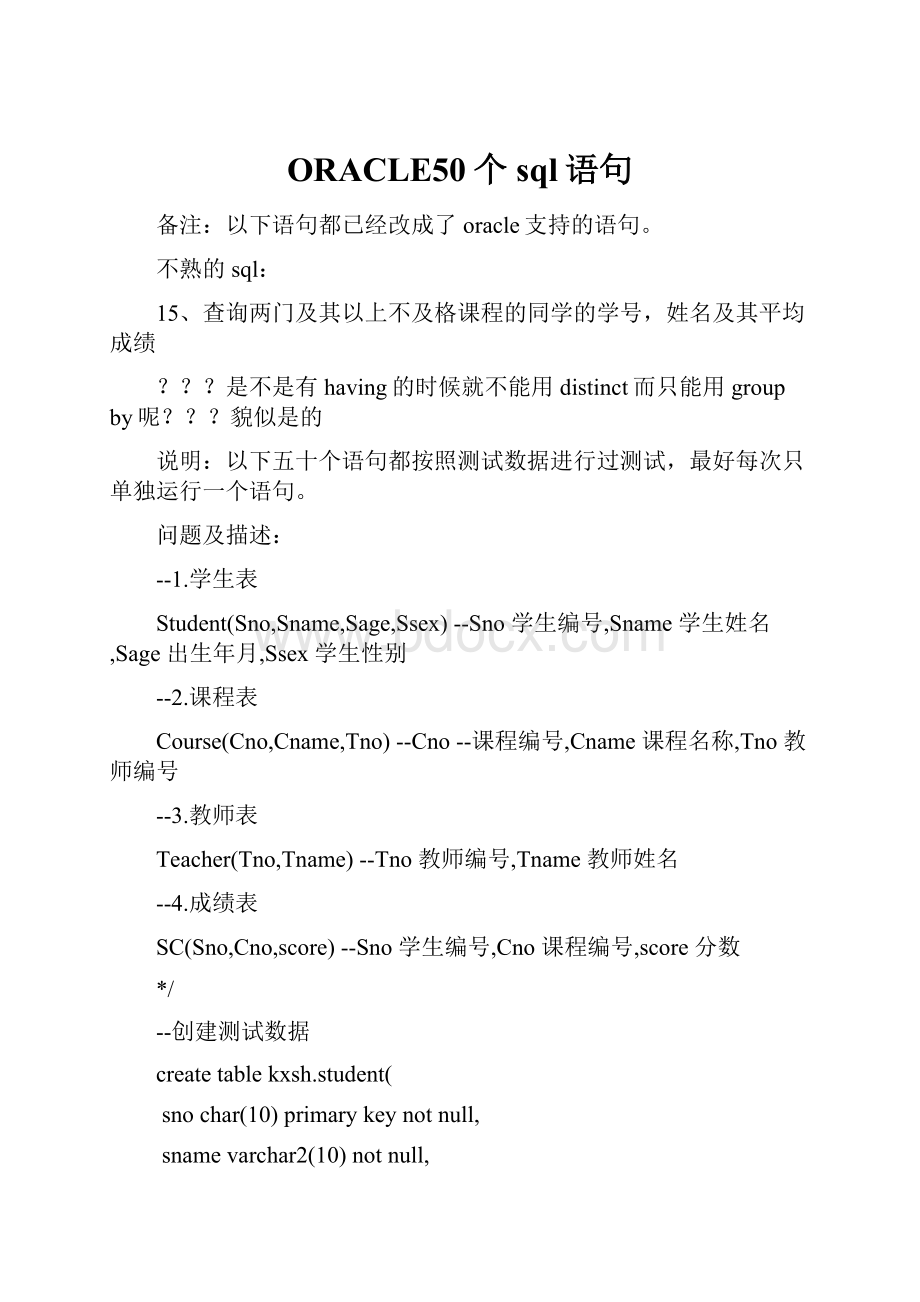ORACLE50个sql语句.docx
《ORACLE50个sql语句.docx》由会员分享,可在线阅读,更多相关《ORACLE50个sql语句.docx(37页珍藏版)》请在冰豆网上搜索。

ORACLE50个sql语句
备注:
以下语句都已经改成了oracle支持的语句。
不熟的sql:
15、查询两门及其以上不及格课程的同学的学号,姓名及其平均成绩
?
?
?
是不是有having的时候就不能用distinct而只能用groupby呢?
?
?
貌似是的
说明:
以下五十个语句都按照测试数据进行过测试,最好每次只单独运行一个语句。
问题及描述:
--1.学生表
Student(Sno,Sname,Sage,Ssex)--Sno学生编号,Sname学生姓名,Sage出生年月,Ssex学生性别
--2.课程表
Course(Cno,Cname,Tno)--Cno--课程编号,Cname课程名称,Tno教师编号
--3.教师表
Teacher(Tno,Tname)--Tno教师编号,Tname教师姓名
--4.成绩表
SC(Sno,Cno,score)--Sno学生编号,Cno课程编号,score分数
*/
--创建测试数据
createtablekxsh.student(
snochar(10)primarykeynotnull,
snamevarchar2(10)notnull,
ssexchar
(2)check(ssexin('男','女'))notnull,
sagedate
);
insertintokxsh.studentvalues('2008111001','赵雷','男','1990-01-01');
insertintokxsh.studentvalues('2008111002','钱电','男','1990-12-21');
insertintokxsh.studentvalues('2008111003','孙风','男','1990-05-20');
insertintokxsh.studentvalues('2008111004','李云','男','1990-08-06');
insertintokxsh.studentvalues('2008111005','周梅','女','1991-12-01');
insertintokxsh.studentvalues('2008111006','吴兰','女','1992-03-01');
insertintokxsh.studentvalues('2008111007','郑竹','女','1989-07-01');
insertintokxsh.studentvalues('2008111008','王菊','女','1990-01-20');
补充1:
date包含年月日时分秒,oracle默认格式为’dd-mon月-yy’(dd日子、mon月份、yy2位的年,如’06-4月-99’1999年4月6日)。
修改日期的默认格式(临时修改,数据库重启之后仍未默认。
永久修改需要修改注册表):
altersessionsetnls_date_format=‘yyyy-mm-dd’;
修改之后,我们可以用熟悉的格式添加日期类型
createtablekxsh.cource(
cnochar
(2)primarykeynotnull,
cnamevarchar(10)notnull,
tnochar(3)referenceskxsh.teacher(tno)
);
insertintokxsh.courcevalues('01','语文','002');
insertintokxsh.courcevalues('02','数学','001');
insertintokxsh.courcevalues('03','英语','003');
createtablekxsh.teacher(
tnochar(3)primarykeynotnull,
tnamevarchar2(10)notnull
);
insertintokxsh.teachervalues('001','张三');
insertintokxsh.teachervalues('002','李四');
insertintokxsh.teachervalues('003','王五');
createtablekxsh.sc(
snochar(10)notnullreferenceskxsh.student(sno),
cnochar
(2)notnullreferenceskxsh.cource(cno),
scoredecimal(18,2),
primarykey(sno,cno)
);
decimal(a,b):
a代表精度,b代表小数位数。
精度是指总的数字位数(小数点左边和右边位数的总和),小数位数是指小数点右边的位数。
精度和小数位数的默认值分别为18和0。
如果在decimal类型中不指定这两个值,Oracle将截断数字的小数部分,而不会产生错误。
insertintokxsh.scvalues('2008111001','01',80);
insertintokxsh.scvalues('2008111001','02',90);
insertintokxsh.scvalues('2008111001','03',99);
insertintokxsh.scvalues('2008111002','01',70);
insertintokxsh.scvalues('2008111002','02',60);
insertintokxsh.scvalues('2008111002','03',80);
insertintokxsh.scvalues('2008111003','01',80);
insertintokxsh.scvalues('2008111003','02',80);
insertintokxsh.scvalues('2008111003','03',80);
insertintokxsh.scvalues('2008111004','01',50);
insertintokxsh.scvalues('2008111004','02',30);
insertintokxsh.scvalues('2008111004','03',20);
insertintokxsh.scvalues('2008111005','01',76);
insertintokxsh.scvalues('2008111005','02',87);
insertintokxsh.scvalues('2008111006','01',31);
insertintokxsh.scvalues('2008111006','03',34);
insertintokxsh.scvalues('2008111007','02',89);
insertintokxsh.scvalues('2008111007','03',98);
--1、查询"01"课程比"02"课程成绩高的学生的信息及课程分数
--1.1、查询同时存在"01"课程和"02"课程的情况
Oracle中必须用双引号!
!
selecta.*,b.score[课程'01'的分数],c.score"[课程'02'的分数]"
fromStudenta,SCb,SCc
wherea.Sno=b.Snoanda.Sno=c.Snoandb.Cno='01'andc.Cno='02'and
b.score>c.score
--1.2、查询同时存在"01"课程和"02"课程的情况和存在"01"课程但可能不存在"02"课程的情况(不存在时显示为null)(以下存在相同内容时不再解释)
selecta.*,b.score[课程"01"的分数],c.score[课程"02"的分数]
fromStudenta
leftjoinSCbona.Sno=b.Snoandb.Cno='01'
leftjoinSCcona.Sno=c.Snoandc.Cno='02'
whereb.score>nvl(c.score,0)
补充:
nvl函数的作用:
如果c.score为null,则用0来代替。
--2、查询"01"课程比"02"课程成绩低的学生的信息及课程分数
--2.1、查询同时存在"01"课程和"02"课程的情况
selecta.*,b.score[课程'01'的分数],c.score[课程'02'的分数]fromStudenta,SCb,SCc
wherea.Sno=b.Snoanda.Sno=c.Snoandb.Cno='01'andc.Cno='02'andb.score--2.2、查询同时存在"01"课程和"02"课程的情况和不存在"01"课程但存在"02"课程的情况
selecta.*,b.score[课程"01"的分数],c.score[课程"02"的分数]fromStudenta
leftjoinSCbona.Sno=b.Snoandb.Cno='01'
leftjoinSCcona.Sno=c.Snoandc.Cno='02'
whereisnull(b.score,0)--3、查询平均成绩大于等于60分的同学的学生编号和学生姓名和平均成绩
selecta.Sno,a.Sname,cast(avg(b.score)asdecimal(18,2))avg_score
fromStudenta,scb
wherea.Sno=b.Sno
groupbya.Sno,a.Sname
havingcast(avg(b.score)asdecimal(18,2))>=60
orderbycast(avg(b.score)asdecimal(18,2))desc
补充2:
最后三句不好理解,可以一行一行的测试,体验它们的功能。
groupby:
用于对查询的结果分组统计(注意:
select中列举了哪些内容,groupby中就要原样的列举出来,聚合函数除外)。
having:
一般同groupby一起使用,用来筛选结果,但也可以不用
Where用在结果集聚合之前,having用在结果集聚合之后。
orderby:
对查询结果进行排序(asc、desc),默认为asc。
cast(AasB)函数:
A代表的是原值,B代表的是一种数据类型。
作用是将A转换成B类型。
decimal(a,b):
a代表精度,b代表小数位数。
精度是指总的数字位数(小数点左边和右边位数的总和),小数位数是指小数点右边的位数。
精度和小数位数的默认值分别为18和0。
如果在decimal类型中不指定这两个值,Oracle将截断数字的小数部分,而不会产生错误。
补充3:
groupby和distinct的区别
这两个作用都是分组查询,实现的功能是一样的。
但是当select语句中有聚合函数时,只能用groupby,用distinct的话会报错。
Selectdistinctsno,sname
Fromstudent
Where.....
如上,distinctsno,sname是将sno、sname这两个字段看成一体,只要sno、sname这两个字段相同,就将其视为重复记录。
Selectsno,sname,count(sno)
Fromstudent
Where.....
Groupbysno,sname
如上,groupbysno,sname是将sno、sname这两个字段看成一体,只要sno、sname这两个字段相同,就将其视为重复记录。
因为select语句中有聚合函数,所以只能使用groupby。
--4、查询平均成绩小于60分的同学的学生编号和学生姓名和平均成绩
--4.1、查询在sc表存在成绩的学生信息的SQL语句。
selecta.Sno,a.Sname,cast(avg(b.score)asdecimal(18,2))avg_score
fromStudenta,scb
wherea.Sno=b.Sno
groupbya.Sno,a.Sname
havingcast(avg(b.score)asdecimal(18,2))<60
orderbya.Sno
--4.2、查询在sc表中不存在成绩的学生信息的SQL语句。
selecta.Sno,a.Sname,nvl(cast(avg(b.score)asdecimal(18,2)),0)avg_score
fromStudenta
leftjoinscbona.Sno=b.Sno
groupbya.Sno,a.Sname
havingnvl(cast(avg(b.score)asdecimal(18,2)),0)<60
orderbya.Sno
--5、查询所有同学的学生编号、学生姓名、选课总数、所有课程的总成绩
--5.1、查询所有有成绩的SQL。
selecta.Sno[学生编号],a.Sname[学生姓名],count(b.Cno)选课总数,sum(score)[所有课程的总成绩]
fromStudenta,SCb
wherea.Sno=b.Sno
groupbya.Sno,a.Sname
orderbya.Sno
--5.2、查询所有(包括有成绩和无成绩)的SQL。
selecta.Sno,a.Sname,count(b.Cno),nvl(sum(score),0)
fromStudenta
leftjoinSCbona.Sno=b.Sno
groupbya.Sno,a.Sname
orderbya.Sno
--6、查询"李"姓老师的数量
selectcount(Tname)["李"姓老师的数量]
fromTeacher
whereTnamelike'李%'
注意:
%表示0到多个字符,_表示任意单个字符
--7、查询学过"张三"老师授课的同学的信息
selectdistinctStudent.*
fromStudent,SC,Course,Teacher
whereStudent.Sno=SC.SnoandSC.Cno=Course.Cnoand
Course.Tno=Teacher.TnoandTeacher.Tname='张三'
orderbyStudent.Sno
注意:
distinct关键字用来过滤掉多余的重复记录,只保留一条。
(其实这里根本用不到这个关键字!
)
--8、查询没学过"张三"老师授课的同学的信息
selectm.*
fromStudentm
whereSnonotin(
selectdistinctSC.Sno
fromSC,Course,Teacher
whereSC.Cno=Course.CnoandCourse.Tno=Teacher.Tno
andTeacher.Tname='张三')
orderbym.Sno
注意:
请先仔细分析下面这个例子,体会exists的作用。
selectNAME
fromS
whereexists
(select‘*’
fromSC
whereCNO='C1‘
andSNO=S.SNO)
in和exists的区别。
in后的子查询与外层查询无关,每个子查询只执行一次;而exists后的子查询与外层查询有关,需要执行多次,称之为相关子查询。
exists:
带有exists关键字的子查询不返回任何数据,只产生逻辑真值true或逻辑假值false。
若内层查询结果非空,则返回真值;若内层查询结果为空,则返回假值。
由exists引出的子查询,其目标列表达式通常都用固定值,因为带exists的子查询只返回真值或假值,给出列名无实际意义。
相关子查询:
首先取外层查询中表的第一个元组,根据它与内层查询相关的属性值处理内层查询,若where字句返回值为真,则取此元组放入结果表;然后再取外层表的下一个元组;重复这一过程,直至外层表全部检查完为止。
--9、查询学过编号为"01"并且也学过编号为"02"的课程的同学的信息
其实最简单的方法如下:
selectdistincta.sno,a.sname
fromstudenta,scb,scc
wherea.sno=b.snoand
a.sno=c.snoand
o='01'and
o='02';
--方法1
selectStudent.*
fromStudent,SC
whereStudent.Sno=SC.SnoandSC.Cno='01'andexists(
Select1
fromSCSC_2
whereSC_2.Sno=SC.SnoandSC_2.Cno='02')
orderbyStudent.Sno
--方法2(这个方法虽然看上去很复杂,但是必须看懂它,进而掌握union和unionall的用法和区别)
selectm.*
fromStudentm
whereSnoin(
selectSno
from(
selectdistinctSnofromSCwhereCno='01'
unionall
selectdistinctSnofromSCwhereCno='02'
)groupbySnohavingcount
(1)=2
)
orderbym.Sno
注意:
union和unionall的用法
Union:
得到两个查询结构的并集,并且自动去掉重复行,不会排序。
Unionall:
得到两个查询结果的并集,不会去掉重复行,也不会排序。
上边方法2的意思是先查出选了‘01’课程的学号和选了‘02’课程的学号(用的unionall,不会去掉重复行,也不会排序),将他们都列出来。
然后选择出现了两次的学号,然后查询这个学号对应的学生的信息
--10、查询学过编号为"01"但是没有学过编号为"02"的课程的同学的信息
--方法1
selectStudent.*
fromStudent,SC
whereStudent.Sno=SC.SnoandSC.Cno='01'andnotexists(
Select1
fromSCSC_2
whereSC_2.Sno=SC.SnoandSC_2.Cno='02')
orderbyStudent.Sno
--方法2
selectStudent.*
fromStudent,SC
whereStudent.Sno=SC.SnoandSC.Cno='01'andStudent.Snonotin(
SelectSC_2.Sno
fromSCSC_2
whereSC_2.Sno=SC.SnoandSC_2.Cno='02')
orderbyStudent.Sno
方法三:
使用关键字minus
select*
fromstudent
wheresnoin(
selectsno
from(
selectsnofromscwherecno='01'
minus
selectsnofromscwherecno='02'))
orderbysno;
注意:
minus和intersect的用法。
Minux:
得到两个查询结果的减集,以第一列进行排序。
Intersect:
得到两个查询结果的交集,按查询结果的第一列进行排序。
上边方法三的意思是:
先查出选修了‘01’和选修了‘02’课程的学生的学号,用‘01’的减去‘02’的,查询所得到的学号。
然后根据学号查询学生的信息。
--11、查询没有学全所有课程的同学的信息
--11.1、
selectStudent.*
fromStudent,SC
whereStudent.Sno=SC.Sno
groupbyStudent.Sno,Student.Sname,Student.Sage,Student.Ssex
havingcount(Cno)<(selectcount(Cno)fromCourse)
注意:
刚开始时写的如下sql语句,试解释为什么不行。
selectStudent.*
fromStudent,SC,Course
whereStudent.Sno=SC.Sno
groupbyStudent.Sno,Student.Sname,Student.Sage,Student.Ssex
havingcount(SC.Cno)答:
通过比较发现上面两个sql语句的主要区别在Cource表的连接位置。
那么为什么第二个就错了呢?
?
注意理解表连接的意思。
在下边这个sql语句中,因为Cource和student、SC进行了表连接,最后生成的结果就是一组数据。
此时数据的行数已经是确定的了,因此count(SC.Cno)和count(Cource.Cno)查出来的结果是一样的,所以执行第二个sql语句永远查不出数据。
--11.2
selectStudent.*
fromStudent
leftjoinSConStudent.Sno=SC.Sno
groupbyStudent.Sno,Student.Sname,Student.Sage,Student.Ssex
havingcount(Cno)<(selectcount(Cno)fromCourse)
--12、查询至少有一门课与学号为"2008111001"的同学所学相同的同学的信息
selectdistinctStudent.*
fromStudent,SC
whereStudent.Sno=